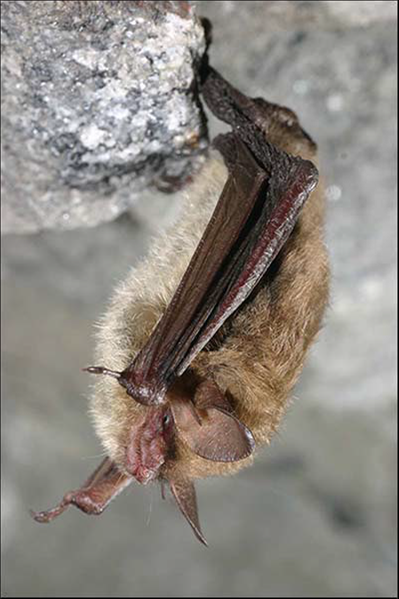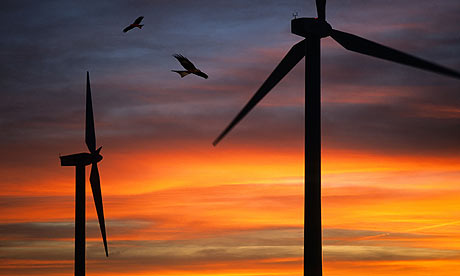Bats are normally considered just another part of Halloween. But the scariest thing about bats is what the world would look like if they no longer existed. Often misunderstood as a species, bats play a crucial role in a healthy, thriving ecosystem. Bats serve as natural pest control and eat many kinds of insects, including mosquitoes. With over 1,400 species, bats help save farmers billions of dollars a year by eating insects that would harm crops and they also play a vital role in pollinating plants in desert and tropical climates, including 300 species of fruits like mangos and bananas.
Each October, Bat Week is celebrated across the globe and raises awareness about the need for bat conservation. The U.S. clean power industry is committed to co-existence with bats when building and maintaining new energy projects and the industry has made positive strides to reduce impact on bats.

Hibernating NLEB. Photo credit: Al Hicks, New York Department of Environmental Conservation (retired).
Wind and solar energy are some of the most environmentally friendly ways of generating electricity. Wind energy has one of the lowest impacts on wildlife and their surrounding habitats of any utility-scale electricity generation.? Good stewardship is a core value for the U.S. clean energy industry and the industry is committed to?further reducing its already low impact on the?environment, including bats.
Clean energy developers take a systematic approach to identifying wildlife impacts and engaging in initiatives to reduce if not eliminate them. The U.S. clean energy industry has a long history of partnering closely with the conservation community and federal and state regulators to solve wildlife challenges.
For nearly three decades, industry leaders have worked collaboratively with conservation partners to develop innovative solutions that support wildlife and the environment. From collaborations with the Department of Energy and NREL, to forming the Renewable Energy Wildlife Institute (REWI) and the Renewable Energy Wildlife Research Fund (REWRF), and The Bats and Wind Energy Cooperative in partnership with conservation and science organizations to implementing technology such as the?NRG’s bat deterrent systems, the clean energy industry is committed to coexistence with wildlife.
Here are just a few of the many ways the clean energy industry is aiding and researching new ways to mitigate bat incidents and ensure thriving ecosystems for our flying mammal friends.
With the company’s core value of sustainability top of mind, Apex Clean Energy strives to not only advance the sustainability of America’s energy system as a whole, but also enhance local ecosystems and habitats where Apex’s projects are developed and operated. That’s why this ACP member company created the Apex Conservation Grant (ACG) program. Eligible projects aim to address local or regional wildlife conservation, reforestation and restoration, or other types of environmentally beneficial projects. The Apex grant—above and beyond any local, state, or federal permit requirements for compensatory mitigation—is proportional to the size of its associated renewable energy project. Projects commercialized by Apex will contribute a sum of money proportional to the size of the project up to $1,000 per megawatt, or more, if appropriate on a case-by-case basis.
Two of the largest grants within the ACG program to date have focused on advancing bat conservation. At Lincoln Land Wind in Morgan County, Illinois, Apex awarded $300,000 for a project that enhances regional habitat for migratory tree-roosting bats, such as the hoary bat, the silver-haired bat, and the eastern red bat. The company is currently choosing finalists for the Young Wind and El Sauz Wind projects, totaling $800,000 in grant funding, which will support bat conservation in Texas through habitat protection, restoration, or other creative solutions.
Invenergy’s Partnership with New York State Department of Environmental Conservation
At ACP member company Invenergy, a multi-year commitment to protect listed bats from predation at one of the remaining New York hibernacula is underway. Invenergy partnered with the New York State Department of Environmental Conservation (NYSDEC) on a mitigation project to address a risk to the state and federally protected northern long-eared bat. Raccoons were accessing a large cave where bats where hibernating, killing numerous bats each year. The Invenergy project team worked with a wildlife consultant to coordinate the trapping and removal of the raccoons at the cave entrance, which eliminated the problem of predation for not only northern long-eared bats, but also for the other bat species using the cave.
Duke Energy’s deployment of NRG System’s Bat Deterrent System
In 2019, ACP member Duke Energy was the first to commercially deploy NRG System’s innovative Bat Deterrent System in the continental U.S. This technology uses high frequency signals to block the echolocation, a radar of sorts, that bats use to navigate in the dark, causing them to avoid areas around wind turbines. Researchers believe the system works by preventing bats from hearing their own echolocation, making it difficult for them to hunt or socialize and causing them to leave the immediate area for more conducive spaces. The system was inspired in part by a natural defense of the tiger moth, which emits its own sound to block bat echolocation.
The results of the study were largely successful, reducing bat fatalities over 54 percent for the Brazilian free-tailed bat and almost 80 percent for the Hoary bat. The latter species is a species of conservation concern that is found throughout the United States.
The clean energy industry supports strong collaboration and research to ensure that wind, solar and storage coexists with wildlife. Achieving a sustainable future depends on significantly expanding our nation’s clean energy supply while also protecting and conserving the environment. The work underway to successfully co-exist with bats by ACP member companies and the industry writ-large takes us one step closer toward reaching that goal. There’s nothing spookier than the idea of not taking the steps necessary to ensure a clean energy future for all.
For more information on bats and clean energy, visit REWI’s Bats and Wind Energy webpage.
Author:
Senior Director, Wildlife & Federal Lands


